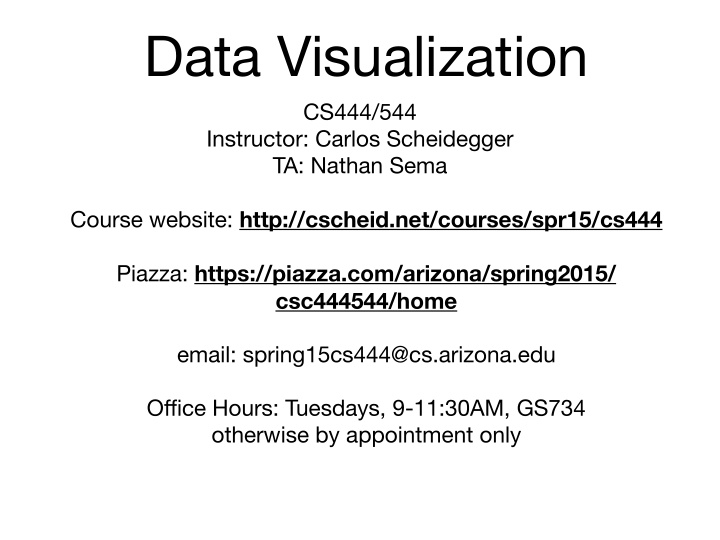



Data Visualization CS444/544 Instructor: Carlos Scheidegger TA: Nathan Sema Course website: http://cscheid.net/courses/spr15/cs444 Piazza: https://piazza.com/arizona/spring2015/ csc444544/home email: spring15cs444@cs.arizona.edu O ffi ce Hours: Tuesdays, 9-11:30AM, GS734 otherwise by appointment only
Three main themes Mechanics : how do I build a visualization? • • Javascript, CSS, HTML, d3 Principles : why should I build it in this way? • • mathematical and perceptual arguments Techniques : how do I turn principles and mechanics • into an actual visualization? • algorithms, software libraries
Assessment One small assignment per week , 50% weight • ~2 hours per assignment • One midterm , 20% weight • hour-long • One final project , 30% weight • as much work as all assignments combined. CS444/544 distinction: want to write a paper? • Class participation , 10% weight • • piazza counts
Grading Performance grade: • • ≥ 90%: A, ≥ 75%: B, ≥ 60%: C, ≥ 40%: D, <40%: F Curve grade: • • ≥ 15%: A, ≥ 30%: B, ≥ 45%: C, ≥ 60: D, <40%: F Your final grade is the best of either curve of • performance grades
Plagiarism and Academic Conduct Policy Unless I state otherwise, you are allowed to use any open source • library you want in your projects, provided that you give it credit . • Most assignments will be small If you pass off someone else’s work as yours, that’s plagiarism . • • The penalty for plagiarism always includes a referral to the college, and ranges from an automatic zero in the assignment to an automatic F in the course to expulsion from the university. Don’t do it. •
Textbook No required textbook, but you won’t regret buying • Munzner’s “Visualization Analysis and Design” All required reading • material will be given in lecture notes, webpages, and research papers http://www.amazon.com/Visualization-Analysis-Design-AK-Peters/dp/1466508914
Important Vis Books William Cleveland, The Elements of Graphing Data , • Visualizing Data John W. Tukey, Exploratory Data Analysis • Jacques Bertin, Semiology of Graphics • Edward Tufte, The Visual Display of Quantitative Information , • Visual Explanations , Envisioning Information Colin Ware, Information Visualization • Come take a look at them during office hours if you’re curious; • they’re not cheap :(
Mechanics Writing programs: we will use the web technology • stack • Javascript, SVG, CSS, HTML, d3
http://bit.ly/1swfb5p http://i.imgur.com/wR3ZxfB.jpg
https://www.destroyallsoftware.com/talks/wat
Stick with it, though! http://bl.ocks.org/mbostock
It’s easy to talk to a server Good reasons to choose the web stack: It’s ubiquitous nanocubes.net It’s fast! apple.com arstechnica.com
Principles Building a visualization is fundamentally about tradeoffs. Principles help us understand these tradeoffs, and make informed decisions
Pre-attentive Processing Examples from Christopher Healey’s excellent resource http://www.csc.ncsu.edu/faculty/healey/PP/
http://www.csc.ncsu.edu/faculty/healey/PP/
http://www.csc.ncsu.edu/faculty/healey/PP/
Change Blindness (photosensitive epilepsy? please look away.)
http://www.csc.ncsu.edu/faculty/healey/PP/
Respect the math in the data Not everything you can do with data makes sense
http://viz.wtf/post/107440754050/ how-payday-loans-add-up#notes
http://viz.wtf/post/107998162170/6-7-gender-neutral#notes
http://imgur.com/gNefvUG/
Techniques How do we turn the mechanics and principles into an actual, working visualization?
Linked views demo: http://square.github.io/crossfilter/
Treemaps demo: GrandPerspective
A tour of visualization and visual thinking http://cscheid.net/courses/spr14/cs444/lectures/week1.html
CS 444/544 Summary 4 weeks of mechanics, 5 weeks of principles, 6 • weeks of techniques ~1 small assignment a week, 1 midterm, 1 project • Course website: http://cscheid.net/courses/spr15/cs444 Today’s lecture: http://cscheid.net/courses/spr15/cs444/lectures/week1.html
Recommend
More recommend